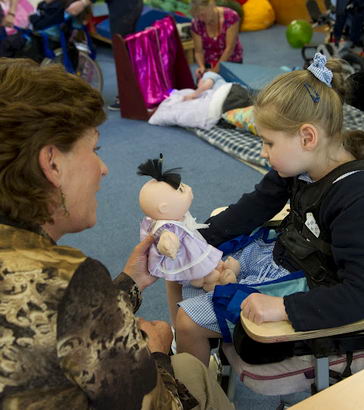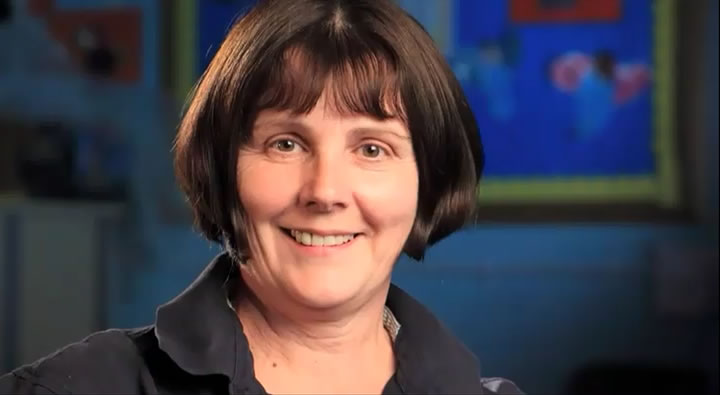A wide range of professionals are required across health and education services providing assessment, treatments, interventions, education and support.
Listen to the audio clip about the contributions made by the community physiotherapist.
Identify the full range of professionals involved where you practice. Which are key workers with regular contact with the child? Identify their key involvement in terms of assessment, treatment, interventions, education and support.
Work with a child can be in hospital or in a clinic for assessment, but more usually in school. Many of the professional team do not see the child on a daily basis and may never go into school. What might that mean for understanding the child's needs?
Consider ways of gaining an all round view of the child's needs. As the difficulties are complex, is there a danger that a specialist looks at the child from only one perspective? How much 'context' is shared between experts and key workers?
Consider the pathways of information between the key workers who see and work with the child regularly and those who contribute specialised expertise. Draw a diagram to show the flow of information that you expect to happen. Ask yourself is this unidirectional, a one way street or a dual carriageway? Make a list of the implications you have drawn.

Consider a child you may know who has special needs and the constellation of supporters surrounding them. How many specialists are directly working with the child compared with the number who contribute from a distance such as from hospitals and educational assessment units?
Consider the key professional experts the child may rely on and the amount of direct contact time each specialist might have with the child. How does the pattern differ between children?

Specialist teachers work directly with children, their teachers and TAs. Their specialities range from academic and intellectual support to teaching of physical skills. They may be qualified teachers with special interests in developing particular skills. They could be therapists trained in special subjects such as speech training and sign language.
Where would they be in the web of support? Sketch a web and
place them.

The personal needs of a child require sensitive support and encouragement.
Who would need to pay close attention to the child's personal needs? Would the role extend beyond making sure these needs are met presently?
Make a list of the further responsibilities of meeting these needs in the future. How might other
people contribute?
Getting to school can be a burden; nursing advice can support the transitions in terms of medication adjustment, protection
and comfort. School nurses, who may be based on the premises or have visiting sessions, can reassure parents about medications,
timing and symptoms and parents can share medical knowledge of their
own child.
The nurse can provide help and guidance for the child's family and all key workers. By monitoring the medical conditions and well-being of the child a nurse can deal with and alert others in case of deterioration of a child's health. Nurses provide a crucial link between education services and NHS services. The medical information they can provide aids therapists and specialists in their work.
Consider the health needs of two children you have focused on. Why was it important to have medical records? How did these records impact on your decisions for the children?
As a result of greater personal need more children with CLDD
are withdrawn from the group, whether in special or mainstream classes. Special schools have areas of privacy which are more
difficult to find in mainstream, but it is important to maintain dignity and develop appropriate personal capabilities
where possible.
One-to-one therapies can require privacy whereas some therapies such as music and art are shared and enjoyed in groups.
Speech and language development can also benefit from individual and group sessions.
Where might problems arise with group sessions? What are the strengths and limitations of teachers and therapists working in the classroom together? How do you think individuals who cannot easily express themselves may have difficulty? Consider frustration, disappointment and feelings in general. How can a teacher or TA help?
The child is central in the web and the key workers are those who work on a daily basis with the individuals. Respecting
dignity and encouraging attainment is ongoing. This builds on shared understanding between child and
key workers.
In this audio clip Harvey's father stresses the importance of continuity but notes that it is not always possible.
Think of your experiences of building relationships and finding trust. How might a child reliant on others feel?

Anning A., Cottrell D., Frost N., Green J. and Robinson M. (2006) Developing Multiprofessional Teamworking for Integrated Children's Services. Maidenhead: Open University Press.
Moore G., McConkey R. and Duffy M. (2003) The role of the school nurse in special schools for pupils with severe learning difficulties. International Journal of Nursing Studies 40 (7) 771-779.
Royal College of Paediatrics and Child Health website

